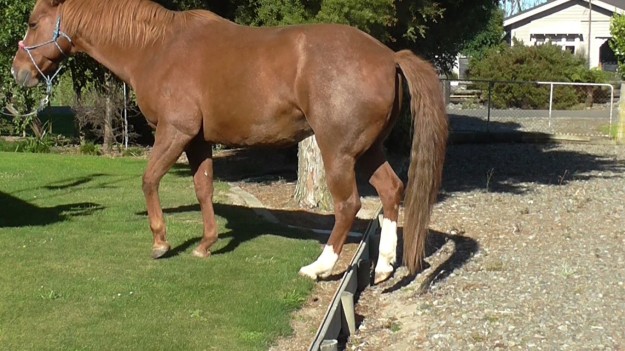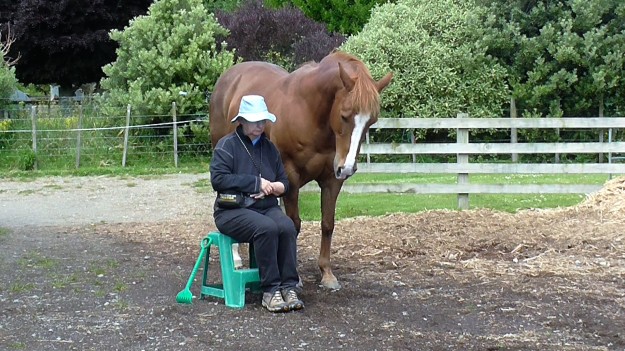INTRODUCTION:
Once the horse understands targeting his shoulder to our hand, we might like to teach targeting his hindquarters to our hand. If we can ask for ‘shoulder to hand’ and ‘hip to hand’ we have a way of asking the horse to bring his whole body toward us.
It’s a useful maneuver when we would like him to line up at a mounting block, fence or bank and he’s not quite close enough. It is also a gymnastic exercise and one that encourages handlers to develop their timing plus clear, consistent body language.
PREREQUISITES:
- Horse and handler are clicker savvy.
- Horse is comfortable standing ‘parked’ with the handler standing alongside facing behind the horse.
- Handler has developed his/her ‘zero intent’ and ‘intent’ body language. To review, see the clip or blog link at the end of this post.
- Signals for moving the hip away from the handler are well established. There are various ways to teaching this. A clip demonstrating one way is also added at the end of this post.
ENVIRONMENT & MATERIALS:
- A work area where the horse is relaxed and confident.
- Ideally, the horse can see his buddies, but they can’t interfere.
- The horse is not hungry.
- A safe, enclosed area for working at liberty, if possible. Otherwise, halter and lead (kept loose or the rope safely draped over the horse’s neck).
- A hand-held target on a long stick, a mid-length target and a short target.
- For generalizations, pedestal, mounting block or similar, hoop.
My current collection of targets. In the video below, I used the three on the right-hand side of the photo. The others come in handy in various contexts.
AIM:
Horse confidently moves his hindquarters toward the handler’s ‘outstretched hand’ signal.
Video Clip: #164 HorseGym with Boots: TARGET HIPS TO HAND https://youtu.be/aYlILbkwsBA
Note: When we request the horse to yield his hip away from us, we project energy toward the horse’s hindquarters from our body’s core at the belly-button, which causes our posture to be upright.
When we request the horse to move toward us, it’s important to pull our belly-button back so that we shrink back and create a ‘draw toward me’ energy with our whole body.
Horses are so sensitive to advancing and receding energy from another body, that they easily read the intent of our posture as long as we are consistent and not sloppy.
SLICES:
Stay with each slice until it feels ho-hum and smooth for both of you.
Make each session extremely short, a few minutes. The magic is not in the final result as much as it is in the process of helping the horse figure it out.
- Choose a spot where you can easily stand the horse alongside a safe fence, wall, or similar with the barrier on the horse’s far side. The barrier discourages the option of moving the hindquarters away, which is something you have hopefully taught previously.
- Ask the horse to stand squarely beside the fence; click&treat.
- Take up a ‘zero intent’ position standing beside the horse’s neck, facing behind the horse, holding the target down by your side ‘out of play’ and relax; click&treat. Work up to standing together quietly like this for three or four seconds before the click&treat, on either side of the horse. Have the space between you and the horse’s neck at a distance comfortable for both of you. Close is usually safer than standing away, but it depends.
- Stretch your arm to gently touch the long-handled target to the side of the horse’s hindquarters. Click just as the target makes contact; deliver the treat.
- Move the target down behind your leg to take it ‘out of play’ and resume the ‘zero intent’ body position. Observe to see if the horse is okay for you to carry on. If he continues to stand in a relaxed manner, he is probably okay to carry on, or you may have sorted out one or more ‘okay to proceed’ signals. A link to information about these is at the end of this post.
- Repeat 4 and 5 above, watching for any weight shift the horse might make toward the target as you move it toward his hindquarters. If he does, celebrate hugely with happy words and a jackpot or triple treat. Maybe ask for one or two repeats, then wait until your next session to do more.
- When you feel the time is right, hold the target a tiny distance away from touching the hindquarters and WAIT for the horse to shift his weight to make the contact; click&treat. Some horses may step over to make the contact right away. For either a weight shift or a whole step toward the target, celebrate hugely again. Maybe repeat the request once or twice more to consolidate the idea. If you have waited 3-4 seconds and nothing happens, simply return to slices 4, 5, 6 above.
- It took Boots a good number of daily mini-sessions before she a) consistently leaned toward the target and b) consistently moved a tiny distance toward the target to make the contact. Then it took more days before she confidently stepped toward the target when I held it further away.
- Decide whether you want to continue teaching on the side you started with, or if you want to teach slices 1-7 on the other side of the horse before proceeding.
- When 7 is ho-hum, gradually hold your target a little bit further away so the horse must take a full step to contact the target; click&treat.
- Whenever the response seems slow or unsure (or is missing), go back to touch the target to the hindquarters; click&treat. Then work forward again at a rate that keeps the horse being continually successful as much as possible.
- This willingness to back up in the teaching is sometimes hard, but we always must go where the horse tell us he is, not where we want him to be.
- When starting a new session, always introduce the task with a touch of the target (and eventually your hand) to the hindquarters; click&treat, to let the horse know which game you are playing.
- Work to having the response equally smooth on either side of the horse.
- You may want to introduce a voice signal to go along with your body language and orientation signals.
- When all is smooth using your long-handled hand-held target, repeat the slices using a shorter target. The one I use in the clip is a soft plastic toy sword.
- When all is smooth with the mid-length target, reach out with an even shorter target. You may have to move from beside his neck to beside his shoulder or ribs, depending on the size of the horse.
- When 16 and 17 are smooth on either side of the horse, ask for the hindquarters over using just your arm lifted up in the same way you did when holding a target. Most horses will respond readily to the arm movement. I personally hold my hand open with my palm facing the horse. Handler body position is upright. By pulling back our belly-button area we create a ‘draw toward me’ energy.
When we ask for hindquarters to yield away, we send energy toward the horse and look down and gesture toward his hocks, so it is a very different body orientation and energy. Plus, we may have added distinct and different voice signals for each one.
It’s good to frequently practice ‘hip away’ and ‘hip toward’ as a little sequence to make sure our signals stay true and the horse easily responds to either one without confusion.
Left photo: ‘hip toward me’ signal and body language. Right photo: ‘hip away please’ signal and body language.
GENERALIZATIONS:
Clip: #165 HorseGym with Boots TARGET BUTT TO HAND:
Generalizations:
- Stand the horse so his shoulder is near a mounting block, but his hindquarters are angled away. Ask him to bring his butt (hip) toward your hand. If he gets confused, return to using your long, medium and short targets, fading out each one as his confidence returns, until your outstretched arm and hand are sufficient.
- Generalize the ‘bring your hip over’ skill to different venues and different mounting situations, e.g. fences, gates, stumps, banks – especially if you ride out in wider and varied environments. Before my hips gave up riding, I would often have been totally grounded after dismounting if Boots wasn’t 100% confident about lining up quietly alongside a gate or any other raised surface in the vicinity.
- If you have a pedestal on which the horse puts his front feet, you can ask him to bring his hindquarters toward you in a circle while his front feet stay on the pedestal.
- Alternately, if you have a soft rubber tub, ask the horse to put his front feet into the tub and repeat 3 above.
- To increase the expertise required (by horse and handler) ask the horse to place his front feet into a hoop and keep them in the hoop while moving his butt to target the handler’s arm (or a target) moving in a circular pattern, both clockwise and anti-clockwise. Start with one step and a high rate of reinforcement.
- Be careful not to ask too much at first. A frequent minute or two of exercises such as these is enough to have a worthwhile gymnastic effect.
- Whenever you do ‘hip toward me’, balance it with ‘hip away please’.
BACKGROUND CLIPS FOR QUICK REVIEW:
Clip: #153 HorseGym with Boots: ZERO INTENT AND INTENT
Clip: May 2018 Challenge: YIELD HINDQUARTERS: https://youtu.be/AkjIT8Tjxw0
Clip: #154 HorseGym with Boots: OKAY TO REPEAT SIGNALS
BLOG LINKS FOR MORE DETAILED REVIEW:
Blog: No Intent and Intent
https://herthamuddyhorse.com/2018/11/30/dec-2018-challenge-no-intent-and-intent/
Blog: Seeking the Horse’s Consent Signals.
https://herthamuddyhorse.com/2018/12/22/seeking-the-horses-consent-signals/)














